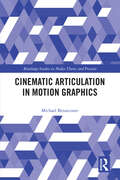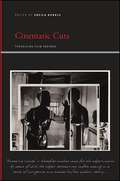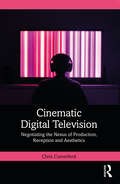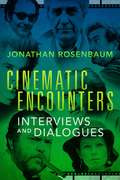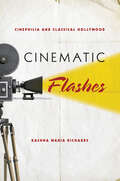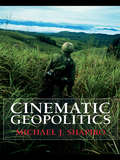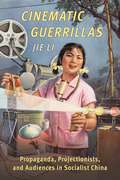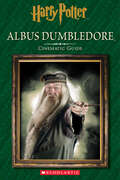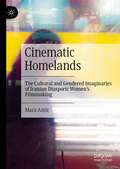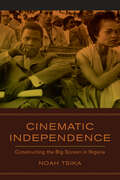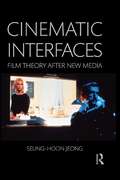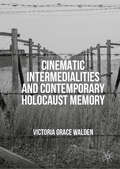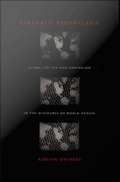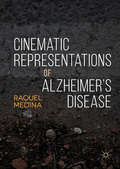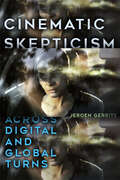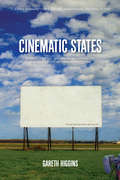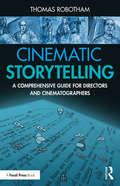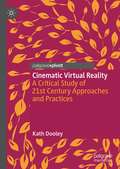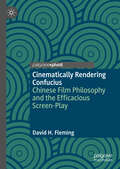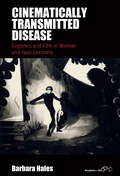- Table View
- List View
Cinematic Articulation in Motion Graphics (Routledge Studies in Media Theory and Practice)
by Michael BetancourtThis book develops a critical and theoretical approach to the semiotics of motion pictures as they are applied to a broader range of constructions than traditional commercial narrative productions. This interdisciplinary approach begins with the problems posed by motion perception to develop a model of cinematic interpretation that includes both narrative and non-narrative types of productions. Contrasting traditional theatrical projection and varieties of new media, this book integrates analyses of title sequences, music videos, and visual effects with discussions on classic and avant-garde films. It further explores the intersection between formative audio-visual cues identified by viewers and how viewers’ desires direct engagement with the motion picture to present a framework for understanding cinematic articulation. This new theoretical model incorporates much of what was neglected and gives greater prominence to formerly critical marginal productions by showing the fundamental connections that link all moving imagery and text, whether it tells a story or not. This insightful work will appeal to students and academics in film and media studies.
Cinematic Cuts: Theorizing Film Endings (SUNY series, Insinuations: Philosophy, Psychoanalysis, Literature)
by Sheila KunkleEditing has been called the language of cinema, and thus a film's ending can be considered the final punctuation mark of this language, framing everything that came before and offering the key to both our interpretation and our enjoyment of a film. In Cinematic Cuts, scholars explore the philosophical, literary, and psychoanalytic significance of film endings, analyzing how film endings engage our fantasies of cheating death, finding true love, or determining the meaning of life. They examine how endings offer various forms of enjoyment for the spectator, from the momentary fulfillment of desire in the happy ending to the pleasurable torment of an indeterminate ending. The contributors also consider how film endings open onto larger questions relating to endings in our time. They suggest how a film ending's hidden counternarrative can be read as a political act, how our interpretation of a film ending parallels the end of a psychoanalytical session, how film endings reveal our anxieties and fears, and how cinema itself might end with the increasing intervention of digital technologies that reorient the spectator's sense of temporality and closure. Films by Akira Kurosawa, Lars von Trier, Joon-Hwan Jang, Claire Denis, Christopher Nolan, Jane Campion, John Huston, and Spike Jonze, among others, are discussed.
Cinematic Digital Television: Negotiating the Nexus of Production, Reception and Aesthetics
by Chris ComerfordChris Comerford explores cinematic digital television as an artistic classification and an academic object of study, and illuminates the slippage in definitions of previously understood media forms. The growth of television as an artistic, informative medium has given rise to shifts in the aesthetic style of the programmes we watch, and this book outlines these shifts along with the contemporary debates and critical theory surrounding them. Comerford looks at the forms and aesthetics of television, the production standards influencing streaming television and the agency of audiences, and provides case studies of key TV shows illustrating these shifts, including Twin Peaks: The Return, WandaVision, Hacks and Russian Doll. Navigating the levels of production and reception in cinematic digital television, the book uses film-inspired TV as a lightning rod for understanding our narrative screen media landscape and the classifications we use to negotiate it. As an essential reading for both scholars and students of media and television studies, this book provides a much-needed consideration of the changing landscape of television.
Cinematic Encounters 2: Portraits and Polemics
by Jonathan RosenbaumEschewing the idea of film reviewer-as-solitary-expert, Jonathan Rosenbaum continues to advance his belief that a critic's ideal role is to mediate and facilitate our public discussion of cinema. Portraits and Polemics presents debate as an important form of cinematic encounter whether one argues with filmmakers themselves, on behalf of their work, or with one's self. Rosenbaum takes on filmmakers like Chantal Akerman, Richard Linklater, Manoel De Oliveira, Mark Rappaport, Elaine May, and Béla Tarr. He also engages, implicitly and explicitly, with other writers, arguing with Pauline Kael--and Wikipedia--over Jacques Demy, with the Hollywood Reporter and Variety reviewers of Jarmusch’s The Limits of Control, with David Thomson about James L. Brooks, and with many American and English film critics about misrepresented figures from Jerry Lewis to Yasujiro Ozu to Orson Welles. Throughout, Rosenbaum mines insights, pursues pet notions, and invites readers to join the fray.
Cinematic Encounters: Interviews and Dialogues
by Jonathan RosenbaumGodard. Fuller. Rivette. Endfield. Tarr. In his celebrated career as a film critic, Jonathan Rosenbaum has undertaken wide-ranging dialogues with many of the most daring and important auteurs of our time. Cinematic Encounters collects more than forty years of interviews that embrace Rosenbaum's vision of film criticism as a collaboration involving multiple voices. Rosenbaum accompanies Orson Welles on a journey back to Heart of Darkness , the unmade film meant to be Welles's Hollywood debut. Jacques Tati addresses the primacy of décor and soundtrack in his comedic masterpiece PlayTime, while Jim Jarmusch explains the influence of real and Hollywoodized Native Americans in Dead Man. By arranging the chapters chronologically, Rosenbaum invites readers to pursue thematic threads as if the discussions were dialogues between separate interviews. The result is a rare gathering of filmmakers trading thoughts on art and process, on great works and false starts, and on actors and intimate moments.
Cinematic Flashes: Cinephilia and Classical Hollywood
by Rashna Wadia RichardsCinematic Flashes challenges popular notions of a uniform Hollywood style by disclosing uncanny networks of incongruities, coincidences, and contingencies at the margins of the cinematic frame. In an agile demonstration of "cinephiliac" historiography, Rashna Wadia Richards extracts intriguing film fragments from their seemingly ordinary narratives in order to explore what these unexpected moments reveal about the studio era. Inspired by Walter Benjamin's preference for studying cultural fragments rather than composing grand narratives, this unorthodox history of the films of the studio system reveals how classical Hollywood emerges as a disjointed network of accidents, excesses, and coincidences.
Cinematic Geopolitics
by Michael J. ShapiroIn recent years, film has been one of the major genres within which the imaginaries involved in mapping the geopolitical world have been represented and reflected upon. In this book, one of America's foremost theorists of culture and politics treats those aspects of the "geopolitical aesthetic" that must be addressed in light of both the post cold war and post 9/11 world and contemporary film theory and philosophy. Beginning with an account of his experience as a juror at film festival’s, Michael J. Shapiro’s Cinematic Geopolitics analyzes the ways in which film festival space and both feature and documentary films function as counter-spaces to the contemporary "violent cartography" occasioned by governmental policy, especially the current "war on terror." Influenced by the cinema-philosophy relationship developed by Gilles Deleuze and the politics of aesthetics thinking of Jacques Ranciere, the book’s chapters examines a range of films from established classics like the Deer Hunter and the Battle of Algiers to contemporary films such as Dirty Pretty Things and the Fog of War. Shapiro’s use of philosophical and theoretical works makes this cutting edge examination of film and politics essential reading for all students and scholars with an interest in film and politics.
Cinematic Guerrillas: Propaganda, Projectionists, and Audiences in Socialist China
by Jie LiHow might cinema make revolution and mobilize the masses? In socialist China, the film exhibition network expanded from fewer than six hundred movie theaters to more than a hundred thousand mobile film projectionist teams. Holding screenings in improvised open-air spaces in rural areas lacking electricity, these roving projectionists brought not only films but also power generators, loudspeakers, slideshows, posters, live performances, and mass ritual participation, amplifying the era’s utopian dreams and violent upheavals.Cinematic Guerrillas is a media history of Chinese film exhibition and reception that offers fresh insights into the powers and limits of propaganda. Drawing on a wealth of archives, memoirs, interviews, and ethnographic fieldwork, Jie Li examines the media networks and environments, discourses and practices, experiences and memories of film projectionists and their grassroots audiences from the 1940s to the 1980s. She considers the ideology and practice of “cinematic guerrillas”—at once denoting onscreen militants, off-the-grid movie teams, and unruly moviegoers—bridging Maoist iconography, the experiences of projectionists, and popular participation and resistance. Li reconceptualizes socialist media practices as “revolutionary spirit mediumship” that aimed to turn audiences into congregations, contribute to the Mao cult, convert skeptics of revolutionary miracles, and exorcize class enemies.Cinematic Guerrillas considers cinema’s meanings for revolution and nation building; successive generations of projectionists; workers, peasants, and soldiers; women and ethnic minorities; and national leaders, local cadres, and cultural censors. By reading diverse, vivid, and often surprising accounts of moviegoing, Li excavates Chinese media theories that provide a critical new perspective on world cinema.
Cinematic Guide: Albus Dumbledore (Harry Potter)
by Felicity BakerThe Essential Film Companion for ALBUS DUMBLEDORE that's perfect for the youngest fans! This hardcover guidebook features your favorite scenes and quotes from all eight Harry Potter movies!The experience of this eBook will be best if viewed on a tablet.
Cinematic Histospheres: On the Theory and Practice of Historical Films
by Rasmus GreinerIn this Open Access book, film scholar Rasmus Greiner develops a theoretical model for the concept of the histosphere to refer to the “sphere” of a cinematically modelled, physically experienceable historical world. His analysis of practices of modelling and perceiving, immersion and empathy, experience and remembering, appropriation and refiguration, combine approaches from film studies, such as Vivian Sobchack’s phenomenology of film experience, with historiographic theories, such as Frank R. Ankersmit’s concept of historical experience. Building on this analysis, Greiner examines the spatial and temporal organization of historical films and presents discussions of mood and atmosphere, body and memory, and genre and historical consciousness. The analysis is based around three historical films, spanning six decades, that depict 1950s Germany: Helmut Käutner’s Sky Without Stars (1955), Jutta Brückner’s Years of Hunger (1980), and Sven Bohse’s three-part TV series Ku’damm 56 (2016).
Cinematic Homelands: The Cultural and Gendered Imaginaries of Iranian Diasporic Women’s Filmmaking
by Mara AnticThis book maps an emerging cycle of films made by Iranian diasporic women filmmakers and produced outside of Iran, focusing on five significant examples: Shirin Neshat’s Women Without Men (2009), Sepideh Farsi’s Red Rose (2014), Maryam Keshavarz’s Circumstance (2011), Ana Lily Amirpour’s A Girl Walks Home Alone at Night (2014) and Desiree Akhavan’s Appropriate Behaviour (2014). These films speak to the emergence of feminist concerns surrounding gender relations, female subjectivity and sexuality in diasporic filmmaking. The book intends to show how the body of recent Iranian diasporic women’s films demonstrates a substantial shift within the existing exilic and diasporic paradigm, requiring analysis of intersectional relations not only between ethnicity, culture and nationality, but also gender and sexuality. Attending closely to the vibrant feminist film culture generated by Iranian women in diaspora, this book aims to interrogate the diversity of women’s filmmaking practices and their role in shaping new representations of female subjectivity and the diasporic condition.
Cinematic Independence: Constructing the Big Screen in Nigeria
by Noah TsikaA free open access ebook is available upon publication. Learn more at www.luminosoa.org.Cinematic Independence traces the emergence, demise, and rebirth of big-screen film exhibition in Nigeria. Film companies flocked to Nigeria in the years following independence, beginning a long history of interventions by Hollywood and corporate America. The 1980s and 1990s saw a shuttering of cinemas, which were almost entirely replaced by television and direct-to-video movies. However, after 1999, the exhibition sector was revitalized with the construction of multiplexes. Cinematic Independence is about the periods that straddle this disappearing act: the immediate decades bracketing independence in 1960, and the years after 1999. At stake is the Nigerian postcolony’s role in global debates about the future of the movie theater. That it was eventually resurrected in the flashy form of the multiplex is not simply an achievement of commercial real estate, but also a testament to cinema’s persistence—its capacity to stave off annihilation or, in this case, come back from the dead.
Cinematic Interfaces: Film Theory After New Media
by Seung-hoon JeongIn this book, Seung-hoon Jeong introduces the cinematic interface as a contact surface that mediates between image and subject, proposing that this mediation be understood not simply as transparent and efficient but rather as asymmetrical, ambivalent, immanent, and multidirectional. Jeong enlists the new media term "interface" to bring to film theory a synthetic notion of interfaciality as underlying the multifaceted nature of both the image and subjectivity. Drawing on a range of films, Jeong examines cinematic interfaces seen on screen and the spectator’s experience of them, including: the direct appearance of a camera/filmstrip/screen, the character’s bodily contact with such a medium-interface, the object’s surface and the subject’s face as "quasi-interface," and the image itself. Each of these case studies serves as a platform for remapping and revamping major concepts in film studies such as suture, embodiment, illusion, signification, and indexicality. Looking to such theories as the ontology of the image and the phenomenology of the body, this original theorization of the cinematic interface not only offers a conceptual framework for rethinking and re-linking film and media studies, but also suggests a general theory of the interface.
Cinematic Intermedialities and Contemporary Holocaust Memory
by Victoria Grace WaldenThis book explores the growing trend of intermediality in cinematic representations of the Holocaust. It turns to the in-betweens that characterise the cinematic experience to discover how the different elements involved in film and its viewing collaborate to produce Holocaust memory. Cinematic Intermedialities is a work of film-philosophy that places a number of different forms of screen media, such as films that reassemble archive footage, animations, apps and museum installations, in dialogue with the writing of Deleuze and Guattari, art critic-cum-philosopher Georges Didi-Huberman and film phenomenologies. The result is a careful and unique examination of how Holocaust memory can emerge from the relationship between different media, objects and bodies during the film experience. This work challenges the existing concentration on representation in writing about Holocaust films, turning instead to the materials of screen works and the spectatorial experience to highlight the powerful contribution of the cinematic to Holocaust memory.
Cinematic Overtures: How to Read Opening Scenes (Leonard Hastings Schoff Lectures)
by Annette InsdorfA great movie’s first few minutes provide the key to the rest of the film. Like the opening paragraphs of a novel, they draw the viewer in, setting up the thematic concerns and stylistic approach that will be developed over the course of the narrative. A strong opening sequence leads the viewer to trust the filmmakers. Other times, opening shots are intentionally misleading as they invite alert, active participation with the film. In Cinematic Overtures, Annette Insdorf discusses the opening sequence so that viewers turn first impressions into deeper understanding of cinematic technique.From Joe Gillis’s voice-over in Sunset Boulevard as he lies dead in a swimming pool to the hallucinatory opening of Apocalypse Now, from the stream-of-consciousness montage as found in Hiroshima, mon amour to the slowly unfolding beginning of Schindler’s List, Cinematic Overtures analyzes opening shots from a range of Hollywood as well as international films. Insdorf pays close attention to how the viewer makes sense of these scenes and the cinematic world they are about to enter. Including dozens of frame enlargements that illustrate the strategies of opening scenes, Insdorf also examines how films explore and sometimes critique the power of the camera’s gaze. Along with analyses of opening scenes, the book offers a series of revelatory and surprising readings of individual films by some of the leading directors of the past seventy-five years. Erudite but accessible, Cinematic Overtures will lead film scholars and ardent movie fans alike to greater attentiveness to those fleeting opening moments.
Cinematic Portrayals of African Women and Girls in Political Conflict (Routledge Contemporary Africa)
by Norita MdegeThis book provides an interdisciplinary exploration of the cinematic representations of the experiences of African women and girls in situations of political conflict. The role of cinema is important in providing information about the situation of women and girls in situations of political conflict, and the main characters often also become signifiers of wider social, political and economic ideas, at both global and local levels. Drawing on fictional and biographical cinematic representations, this book considers films covering a range of different regions, experiences, historical periods and other contexts, to draw a nuanced picture of African women and girls who participate in or are affected by African political conflicts. The films are analysed using a decolonial feminist cultural approach, which combines cultural approaches, African feminisms and the contrapuntal method to ensure an inter-textual, intersectional and decolonial examination. The book engages with multiple themes and topics, including nationalism, nation-building, neocolonialism, memory, history, women’s and girls’ agency and activism. Through these themes and topics, the book explores how the films represent African women’s and girls’ agency in relation to their participation in social, economic and political activities. This book will make a significant contribution to literature focused on African women and girls within politics, conflict studies and film studies.
Cinematic Prophylaxiscine: Globalization and Contagion in the Discourse of World Health
by Kirsten OstherrA timely contribution to the fields of film history, visual cultures, and globalization studies, Cinematic Prophylaxis provides essential historical information about how the representation of biological contagion has affected understandings of the origins and vectors of disease. Kirsten Ostherr tracks visual representations of the contamination of bodies across a range of media, including 1940s public health films; entertainment films such as 1950s alien invasion movies and the 1995 blockbuster Outbreak; television programs in the 1980s, during the early years of the aids epidemic; and the cyber-virus plagued Internet. In so doing, she charts the changes--and the alarming continuities--in popular understandings of the connection between pathologized bodies and the global spread of disease. Ostherr presents the first in-depth analysis of the public health films produced between World War II and the 1960s that popularized the ideals of world health and taught viewers to imagine the presence of invisible contaminants all around them. She considers not only the content of specific films but also their techniques for making invisible contaminants visible. By identifying the central aesthetic strategies in films produced by the World Health Organization, the Centers for Disease Control, and other institutions, she reveals how ideas about racial impurity and sexual degeneracy underlay messages ostensibly about world health. Situating these films in relation to those that preceded and followed them, Ostherr shows how, during the postwar era, ideas about contagion were explicitly connected to the global circulation of bodies. While postwar public health films embraced the ideals of world health, they invoked a distinct and deeply anxious mode of representing the spread of disease across national borders.
Cinematic Representations of Alzheimer’s Disease
by Raquel MedinaThis book offers a cross-cultural approach to cinematic representations of Alzheimer’s disease in non-mainstream cinema. Even though Alzheimer’s disease, the most common form of dementia, is a global health issue, it is not perceived or represented homogenously around the world. Contrary to very well-known mainstream films, the films discussed do not focus on the negative aspects normally associated with Alzheimer’s disease, but on the importance of portraying the perspective of the persons living with Alzheimer’s and their personhood. Similarly, this book analyses how the films use Alzheimer’s as a trope to address issues relating to different areas of life and society such as, for example, family matters, intergenerational relationships, gender issues, national traditions versus global modernity, and caring for people with dementia. By examining an array of films, from crime fiction to documentary, that each present non-stigmatising representations of Alzheimer’s disease, this in-depth study ultimately demonstrates the power of culture in shaping meaning.
Cinematic Skepticism: Across Digital and Global Turns
by Jeroen GerritsBecause of its automatic way of recording reality, film has a privileged relation to the problem of skepticism. If early film theorists celebrate cinema for overcoming skeptical doubt about the power of human vision, recent film-philosophers argue that our postphotographic, digital cinema is heading toward a general acceptance of skepticism, as though nothing on screen has anything to do with reality any longer. Emerging from the interaction of Stanley Cavell's and Gilles Deleuze's film-philosophies, Cinematic Skepticism challenges both these views. Jeroen Gerrits takes the issue of skepticism beyond concern with knowledge, turning skepticism into an ethical problem that pervades film history and theory. At the same time, he rethinks a Cavello-Deleuzian approach across the digital and global turns in cinema. Combining clear explanations of complex philosophical arguments with in-depth analyses of the contemporary films Grizzly Man, Amélie, Three Monkeys, and The Headless Woman, Gerrits traces how cinema invents ways of dis/connecting to the world.
Cinematic States: Stories We Tell, the American Dreamlife, and How to Understand Everything*
by Gareth HigginsA Northern Irish writer explores his adopted homeland through film in this irreverent yet moving journey through each of the 50 states. Set among a personal backdrop of immigration memoir, he takes on American myths in their most powerful form--the motion picture--by setting out to determine if a Kansas yellow brick road really does lead to the end of the rainbow, and whether it first has to pass through Colorado's Overlook Hotel. Amid the multipurpose woodchippers, friendly exorcists, and faulty motel showers, resurrected baseball players, and miracle-working gardeners, he examines what the stories we tell reveal about American lives and uses this to sum up what he has learned about the promises, failures, and hope that is America.
Cinematic Storytelling: A Comprehensive Guide for Directors and Cinematographers
by Thomas RobothamThis book presents a new, story-based approach to cinematic coverage and storytelling in film and video. It breaks from the conventional idea that shots are the fundamental unit of filmmaking, instead exploring the specifics of determining coverage. Keyframes in patterns are introduced, delivering scripted material in a context-rich presentation that supports the storytelling. All the analysis, interpretation, and creative decision making is done first, with shots derived as the very last step. Scripted material is divided into six categories with associated patterns. Like cinematic building blocks, these can freely stack up and interconnect, supporting creativity and avoiding rigid formulas. This approach enables filmmakers to tap into the film "language" that audiences already understand and put it to practical use, helping the audience to feel the storytelling deeply. Dozens of film examples are provided throughout, plus conceptual and camera diagrams to contextualize the methods presented, and exercises are provided to reinforce concepts. Emphasis is placed on supporting performance and story meaning through a cinematic context. With all the concepts and decision-making options described and shown in examples, a scripted scene is analyzed and developed through an eight-step process, illustrated with storyboard, camera diagrams, and ultimately shot list descriptions. The book is ideal for filmmaking students interested in directing and cinematography, as well as aspiring and early-career filmmakers, cinematographers, and directors.
Cinematic Virtual Reality: A Critical Study of 21st Century Approaches and Practices
by Kath DooleyWith reference to traditional film theory and frameworks drawn from fields such as screenwriting studies and anthropology, this book explores the challenges and opportunities for both practitioners and viewers offered by the 360-degree storytelling form. It focuses on cinematic virtual reality (CVR), a format that involves immersive, high quality, live action or computer-generated imagery (CGI) that can be viewed through head mounted display (HMD) goggles or via online platforms such as YouTube. This format has surged in popularity in recent years due to the release of affordable high quality omnidirectional (360-degree) cameras and consumer grade HMDs. The book interrogates four key concepts for this emerging medium: immersion, presence, embodiment and proximity through an analysis of innovative case studies and with reference to practitioner interviews. In doing so, it highlights the specificity of the format and provides a critical account of practitioner approaches to the concept development, writing and realisation of short narrative CVR works. The book concludes with an account of the author’s practice-led research into the form, providing a valuable example of creative practice in the field of immersive media.
Cinematically Rendering Confucius: Chinese Film Philosophy and the Efficacious Screen-Play
by David H. FlemingCinematically Rendering Confucius marks the first book-length enquiry into China’s first two big screen treatments of arguably the best-known and most influential thinker in world history: Confucius. By interweaving methods drawn from Film Studies, Comparative Philosophy, and Media Archaeology in response to broader calls to deepen and thicken the scope and purview of film philosophical enquiry, this trailblazing book grounds Fei Mu’s 1940 patriotic art film Kǒng Fūzǐ and Hu Mei's 2010 “Huallywood” blockbuster Kǒngzǐ as pre- and postsocialist examples of Chinese politico-philosophical filmmaking that straddle the PRC’s revolutionary Marxist socio-political experiment. After exploring the geopolitics surrounding why Confucius has been historically included and excluded from the European classification of “philosopher” and addressing the difficulties that entering into “Chinese Thought” presents to non-natives, the book’s first half undertakes a deep dive into the history of (re)mediating the Confucian image-imagination. Arguing that Confucius might be a form of film philosopher avant la lettre, we thereafter explore repetitions and differences surrounding the ever-changing treatment and representation of Confucius on-screen—concluding with a look at the latest AI-infused theory-film When Marx Met Confucius (2023).
Cinematically Transmitted Disease: Eugenics and Film in Weimar and Nazi Germany (Film Europa #28)
by Barbara HalesPropaganda played an essential role in influencing the attitudes and policies of German National Socialism on racial purity and euthanasia, but little has been said on the impact of medical hygiene films. Cinematically Transmitted Disease explores these films for the first time, from their inception during the Weimar era and throughout the years to come. In this innovative volume, author Barbara Hales demonstrates how medical films as well as feature films were circulated among the German people to embed and enforce notions of scientific legitimacy for racial superiority and genetically spread “incurable” diseases, creating and maintaining an instrumental fear of degradation in the German national population.
Cinematography
by Kris Malkiewicz M. David MullenThe Essential Guide to the Cameraman's Craft Since its initial publication in 1973, Cinematography has become the guidebook for filmmakers. Based on their combined fifty years in the film and television industry, authors Kris Malkiewicz and M. David Mullen lay clear and concise groundwork for basic film techniques, focusing squarely on the cameraman's craft. Readers will then learn step-by-step how to master more advanced techniques in postproduction, digital editing, and overall film production. This completely revised third edition, with more than 200 new illustrations, will provide a detailed look at: How expert camera operation can produce consistent, high-quality results How to choose film stocks for the appearance and style of the finished film How to measure light in studio and location shooting for the desired appearance How to coordinate visual and audio elements to produce high-quality sound tracks Whether the final product is a major motion picture, an independent film, or simply a home video, Cinematography can help any filmmaker translate his or her vision into a quality film.
